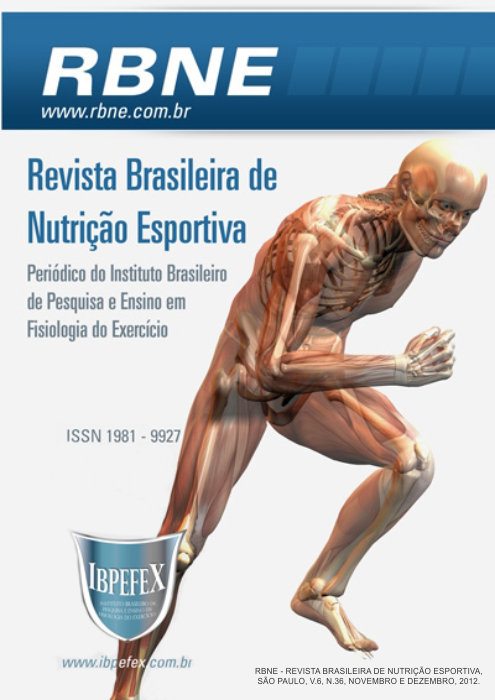Consumption of sports drinks for bodybuilders
Abstract
The present study aimed to evaluate the necessity of the use of electrolyte drinks by bodybuilders, by consuming food and nutritional needs as sex, age, type and duration of training conducted. A total of 18 bodybuilders that use energetic repositories were evaluated on a gym located at Lajeado city. A questionnaire was administered to evaluate the food consumption and another structured questionnaire concerning the lifestyle of the person, physical exercise and use of sports drinks. Nutritional evaluation was performedthrough the Body Mass Index (BMI). The Gatorade sport drink was the most consumed with 55.6% (n = 10) of the participants. The mean of the carbohydrate macronutrient consumed within three days observed were 56.52% (NS), 54.71% (NS) and 57.19% (NS) showed no significant difference when compared with the reference values of DRI (2002). Among the micronutrients analyzed, it was found that potassium did not reach its maximum recommended (4.7 g / day), significantly less than the reference value (DRI) (3.12 g / day (p = 0.000), 2.48 g / day (p = 0.000) and 2.66 g / day (p =0.000)). Regarding sodium, it was found that the amount consumed per day was 3.18 g (p = 0.000), 2.29 g (p = 0.002) and 2.56 g (p = 0.001) and it was significantly higher than the reference value (1.5 g / day). Thus it is concluded that ingestion of electrolytic drink is not suitable for the population studied, since the quantity of sodium ingested with food and isotonic exceeded the recommended amount, and this characterizes a risk factor for developing hypertension and other chronic diseases in the future.
References
-Albino, C. S.; Campos, P. E.; Martins, R. L. Avaliação do consumo de suplementos nutricionais em academias de Lages SC. Revista Digital Efdeportes. Buenos Aires. Vol. 14. Num. 134. 2009.
-Bassit, R. A. Efeitos da ingestão de diferentes soluções contendo carboidratos, eletrólitos e glicerol sobre parâmetros fisiológicos e bioquímicos de atletas submetidos a uma corrida de 30Km em ambiente de calor intenso. Revista Brasileira de Medicina do Esporte. Niterói. Vol. 1. Num. 3. 2002.
-Brasil. Ministério da Saúde. Agência Nacional de Vigilância Sanitária -ANVISA. Portaria Num. 222, de 24 de março de 1998. Brasília. 1998.
-Carvalho, T.; De Mara, L.S. Hidratação e Nutrição no esporte. Revista Brasileira de Medicina do Esporte. Niterói. Vol. 16. Num. 2. 2010. p. 144-148.
-De Lima, C.; Michels, M. F.; Amorim, R. Os diferentes tipos de substratos utilizados na hidratação do atleta para melhora de desempenho. Revista Brasileira de Nutrição Esportiva. São Paulo. Vol.1. Num 1. 2007. p. 73-83.
-De Mara, L. S.; Lemos R.; Brochi, L.; Rohlfs I. C. P. M.; Carvalho T. Alterações hidroeletrolíticas agudas ocorridas no Triatlon Ironman Brasil. Niterói. Revista Brasileira de Medicina do Esporte. Vol. 13. Num. 6. 2007. p. 397-401.
-DRI DIETARY REFERENCE INTAKES FOR Calcium, Phosphorus, Magnesium, Vitamin D, and Fluoride. Standing Committee on the Scientific Evaluation of Dietary Reference Intakes, Food and Nutrition Board, Institute of Medicine. Washington (D.C.): National Academy Press. 1997. P. 448.
-Ferreira, G. F.; Altoé, J. L.; Silva. R. P.; Tsai, L. P.; Fernandes, A A.; Brito, C. J., Martins,. J. C. B. Nível de conhecimento e práticas de hidratação em atletas de futebol de categoria de base. Revista Brasileira Cineantropometria e Desempenho Humano. Vol. 11. Num. 2. 2009. p. 202-209.
-Guerra I.; Alves L. A.; Biesek, S. Estratégias de Nutrição e Suplementação no Esporte. 2ª edição. 2010. p. 148.
-Hernandez A. J.; e colaboradores. Diretriz da Sociedade Brasileira de Medicina do Esporte. Modificações dietéticas, reposição hídrica, suplementos alimentares e drogas: comprovação de ação energética e potenciais riscos para a saúde. Revista Brasileira de Medicina do Esporte. Niterói. Vol. 15. Num. 3. 2009.
-HirchbruchM. H.; Fisberg M.; Mochizuki L. Consumo de suplementos por jovens freqüentadores de academias de ginástica em São Paulo. Revista Bras. Med Esporte. Niterói. Vol. 14. Num. 6. 2008. p. 539-543.
-Machado-Moreira, C. A.; Gomes, A. C V.; Garcia E. S; Rodrigues, L. O. C. Hidratação durante o exercício: a sede é suficiente? Revista Brasileira de Medicina do Esporte. Niterói. Vol.12. Num. 6. 2006. p. 405-409.
-Organização Mundial da Saúde (OMS). Classificação do estado nutricional. 1998.
-Pereira, R. F.; Lajolo F. M.; Hirschbruch. M. D. Consumo de suplementos por alunos de academias em ginástica de São Paulo. Revista de Nutrição. Campinas. Vol. 16. Num. 3. 2003. p. 265-272.
-Pimenta M. G.; Lopes A.C. Consumo de Suplementos nutricionais por praticantes de atividade física de academias de ginástica de Cascavel-PR. Cascavel -PR. Fundação Assis Gurgacz -FAG. 2008. p. 24.
-Rocha M. R.; Vieira L. V.; Lima M. R. Utilização de Suplementos Nutricionais por praticantes de exercícios físicos de três academias de Salvador-BA. Salvador -BA. Faculdade de Tecnologia e Ciências. 2011. p. 17.
Authors who publish in this journal agree to the following terms:
- Authors retain the copyright and grant the journal the right of first publication, with work simultaneously licensed under the Creative Commons Attribution License BY-NC which allows the sharing of the work with acknowledgment of the authorship of the work and initial publication in this journal.
- Authors are authorized to enter into additional contracts separately for non-exclusive distribution of the version of the work published in this journal (eg, publishing in institutional repository or book chapter), with acknowledgment of authorship and initial publication in this journal.
- Authors are allowed and encouraged to post and distribute their work online (eg, in institutional repositories or on their personal page) at any point before or during the editorial process, as this can bring about productive change as well as increase impact and impact. citation of published work (See The Effect of Free Access).






